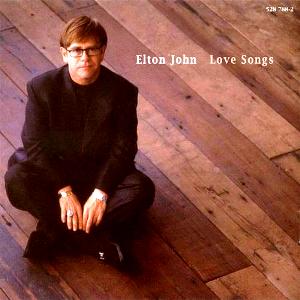Related Research Articles

The Clovers are an American rhythm and blues/doo-wop vocal group who became one of the biggest selling acts of the 1950s. They had a top 30 US hit in 1959 with the Leiber and Stoller song "Love Potion No. 9".
"He" is a song about God, written in 1954. The song made the popular music charts the following year.
"Goodnite, Sweetheart, Goodnite" is a popular song that was a hit during the mid-1950s. It was written by Calvin Carter and James "Pookie" Hudson in 1951, and was first recorded by The Spaniels in 1953. It has also been released by some artists as "Goodnight, Well It's Time to Go".

Love Songs is a compilation album by British singer-songwriter Elton John. The album was first released on 6 November 1995 by John's own label The Rocket Record Company, in conjunction with Mercury Records. The album was released in North America by MCA Records almost a year after the European release, on 24 September 1996. In the US, it was certified gold in December 1996, platinum in March 1997, 2× platinum in December 1998 and 3× platinum in August 2000 by the RIAA.
"The Wallflower" is a 1955 song by Etta James. It was one of several answer songs to "Work with Me, Annie" and has the same 12-bar blues melody.

"After Midnight" is a rock song by J. J. Cale, first released in 1966. Eric Clapton later covered it for his eponymous album, released in 1970. Clapton's rendition became a success, prompting Cale to re-record the song for Cale's 1972 album Naturally. In 1988, Clapton later re-recorded the song for a Michelob beer commercial and then released the re-recording as a single. "After Midnight" has been considered one of Clapton's signature songs throughout his career. Other artists covered the song in later years.

"Whatchulookinat" is a 2002 single released by American R&B/pop singer Whitney Houston. The song serves as the initial single from Houston's fifth studio album, Just Whitney. "Whatchulookinat" has several remixes from Thunderpuss, Full Intention, Junior Vasquez, Peter Rauhofer, Razor 'N Guido and P. Diddy.

"Smoke! Smoke! Smoke! " is a Western swing novelty song written by Merle Travis and Tex Williams, for Williams and his talking blues style of singing. Travis wrote the bulk of the song. The original Williams version went to number one for 16 non-consecutive weeks on the Hot Country Songs chart and became a number one hit in August 1947 and remained at the top of the "Best Sellers in Stores" chart for six weeks. Recorded on March 27, 1947, at Radio Recorders in Hollywood.
"The Young Ones" is a single by Cliff Richard and the Shadows. The song, written by Sid Tepper and Roy C. Bennett, is the title song to the 1961 film The Young Ones and its soundtrack album.
"Count Me Out" is a song released as a single by R&B/pop group New Edition from their All for Love album, released in September 1985 on the MCA label.
Lucky Lips is a song written by Jerry Leiber and Mike Stoller. It was originally recorded by Ruth Brown in 1956 and was successfully covered by Cliff Richard in 1963.
"(Mama) He Treats Your Daughter Mean" is a song written by Johnny Wallace and Herbert J. Lance and recorded by Ruth Brown in 1952. It was Brown's third number-one record on the US Billboard R&B chart and her first pop chart hit.
Earl Gaines, Jr. was an American soul blues and electric blues singer. Born in Decatur, Alabama, he sang lead vocals on the hit single "It's Love Baby ", credited to Louis Brooks and his Hi-Toppers, before undertaking a low-key solo career. In the latter capacity he had minor success with "The Best of Luck to You" (1966) and "Hymn Number 5" (1973). Noted as the best R&B singer from Nashville, Gaines was also known for his lengthy career.
Wallichs Music City was a record store in Hollywood, California, USA, founded by Glenn E. Wallichs, that also had stores in West Covina, Lakewood, Canoga Park, Costa Mesa, Torrance, and Hawthorne from 1940–1978 and was one of the first to display cellophane sealed albums in racks. Wallichs stayed open until 2 am.
Theodore Roosevelt "Ted" Jarrett Jr. was an American singer-songwriter and producer of country, gospel, and soul music.
Louis Brooks, born Louie O'Neal Brooks was an American R&B saxophonist and bandleader, whose recording of "It's Love Baby ", featuring vocalist Earl Gaines, reached no.2 on the US Billboard R&B chart in 1955.
"Feel So Fine" is a song released in 1960 by Johnny Preston. The song is a reworking of the 1955 song "Feel So Good" by Shirley & Lee, with modified lyrics.
LeMuel Nigel Humes is an American songwriter and producer. He has written several songs including Miki Howard’s "Love Will Find A Way", The Pointer Sisters "He Turned Me Out", and Ray Charles "Let Me Take Over".
"Looking Back" is a song written by Brook Benton, Belford Hendricks, and Clyde Otis and performed by Nat King Cole. It reached #2 on the U.S. R&B chart and #5 on the U.S. pop chart in 1958.

"Do It or Die" is a song by Atlanta Rhythm Section. It was released as a single in 1979 from their album Underdog.
References
- ↑ Jason Ankeny & Bruce Eder. "Earl Gaines". Billboard. Retrieved September 17, 2011.
- ↑ "Rhythm & Blues Records: Best Sellers in Stores". Billboard. September 10, 1955. p. 48.
- ↑ "Rhythm & Blues Records: Best Sellers in Stores". Billboard. October 1, 1955. p. 69.
- ↑ "Billboard". Nielsen Business Media, Inc. September 10, 1955. p. 49 – via Google Books.
- ↑ "Billboard". Nielsen Business Media, Inc. September 17, 1955. p. 57 – via Google Books.